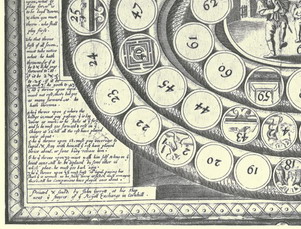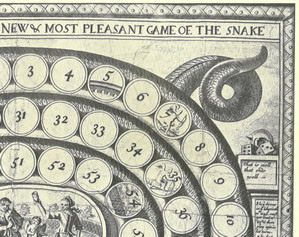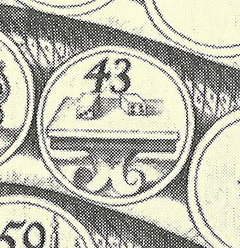Giochi dell'Oca e di percorso
(by Luigi Ciompi & Adrian Seville)
(by Luigi Ciompi & Adrian Seville)

|
Giochi dell'Oca e di percorso
(by Luigi Ciompi & Adrian Seville) |

|
 |

Torna alla ricerca giochi (back to game search) |
 |
| Royall (The) Pass-Tyme of Cupid or the New&Most Pleasant Game of the Snake | ||
 |
Versione stampabile
 |
Invia una segnalazione

|
                   |
primo autore: | Anonimo |
| secondo autore: | Garrett John | |
| anno: | 1690/1700 | |
| luogo: |
Inghilterra-Londra |
|
| periodo: | XVII secolo (4°/4) XVIII secolo (1°/4) | |
| percorso: | Percorso di 63 caselle numerate | |
| materiale: | carta incollata su tela (engraving on paper with linen backing) | |
| dimensioni: | 000X000 | |
| stampa: | Acquaforte (taille-douce) (ecthing) | |
| luogo acquisto: | ||
| data acquisto: | ||
| dimensioni confezione: | ||
| numero caselle: | 63 | |
| categoria: | Amore, matrimonio e famiglia | |
| tipo di gioco: | Gioco di percorso | |
| editore: | Garrett John | |
| stampatore: | Printed and sould by John Garrett at his Shop next ye Stayres of ye Royall Exchange in Cornhill. | |
| proprietario: | Da: Whitehause, F.R.B.: "Table Games of Georgian and Victorian Days" | |
| autore delle foto: | L. Ciompi | |
| numero di catalogo: | 2354 | |
| descrizione: |
Gioco di 63 caselle numerate, spirale, orario, centripeto che ha la forma di un serpente. Questo gioco forse ha ispirato un gioco della metà del XVIII secolo realizzato da Robert Sayer, mercante di carte e di stampe a cui successero nel 1794 Robert Laurie e James Whittle e nel 1813 Richard H. Laurie. L'antico gioco egiziano del serpente, di forma spirale, può aver ispirato molti giochi di società, ma le regole rimangono sconosciute. Nel Gioco del Serpente alla casella 63 si può osservare: - tre coppie di amanti con Cupidi fra le nuvole (De Jode Pieter 1620ca / Veuve Petit 1640ca); - Cupido che affila la punta della sua freccia in un giardino (Laurie&Whittle, 1794 / Lumsden, 1810-1830ca / R. H. Laurie,1850ca); - una coppia contadina che balla accompagnata da un Cupido che suona uno strumento (Visscher, 1625ca / Garrett, 1690ca / Dicey, 1736-40); - un Cupido da solo con il suo arco (Carington Bowles 1756 / Bowles&Carver 1763-1780ca); - due personaggi che giocano a tavola in presenza di un Cupido (Anonimo XVIII° secolo). In questo esemplare al centro troviamo una coppia contadina che balla accompagnata da un Cupido che suona uno strumento. In basso a sinistra: "Printed & Sould by John Garrett at his Shop next ye Stayres of ye Royall Exchange in Cornhill". Non esiste una versione italiana di questo gioco ad esclusione de "Il Novo et Piacevol Gioco del Giardin d’Amore (Arch. n°1105) che a parità di tema si gioca però come il gioco della civetta. REGOLE: ai lati del tavoliere. CASELLE: mute. Cas. 1) Porta; Cas. 5) Ponte; Cas. 7) Cupido; Cas. 12) Sedia; Cas. 14) Cupido; Cas. 16) Tavolo con dadi (6+1); Cas. 18) Cupido; Cas. 21) Cupido; Cas. 25) Tavolo con dadi (5+2); Cas. 28) Cupido; Cas. 30) Fontana; Cas. 35) Cupido; Cas. 38) Cupido; Cas. 42) Cupido; Cas. 43) Tavolo con dadi (3+4); Cas. 46) Labirinto; Cas. 49) Cupido; Cas. 54) Bosco; Cas. 56) Cupido; Cas. 59) Sepolcro; Cas. 63) Coppia contadina che balla accompagnata da un Cupido che suona uno strumento. NOTA: vedi esemplari Arch. n°1240, Arch. n°1309, Arch. n°2341, Arch. n°2342, Arch. n°2487 Arch. n°2488, Arch. n°2489, Arch. n°2490. REFERENZA 1 WHITEHOUSE, Francis Reginald Beaman, (pag. 56): THE ROYALL PASS-TYME OF CUPID, or the New & Most Pleasant Game of The Snake. Printed and sould by John Garrett at his Shop next ye Stayres of ye Royall Exchange in Cornhill. An engraving on laid paper uncut and uncoloured, size 18 in X 14 ¾ in, representing a coiled snake wearing a crown on his head, upon the coils are 62 circles, No. 63, the central panel, is termed “The Delightfull Garden of Cupid". The complete "Directions how to play” are as follows: 1 “Haveing a pare of dice, it must be first agreed upon, what to play for, which is to be layd downe, & then you must throw - who shall play first. 2 “He that throws first of all Seven, must take notice what he hath throwne, for if it be 1 & 6, he goes forward to 16, if it be 2 & 5, to 25, if it be 4 and 3, he goeth to 43. 3 “He that throws upon cupid must not rest there, but goe as many forward as he hath throwne. 4 "'He that throws upon 5 where the bridge is, must pay passage: that is, lay downe as much as he stake at ye first, and so he must goe forward to rest on ye chayre at 12 till all the rest have played once about. 5 “He that throws upon 18, must pay beveridge to Cupid, & stay with him till ye rest have played twice about or some body releace him. 6 “He that throws upon 30 must wash him self so long in ye fountayne till he be displaced by some other in whose place he must goe back agin. 7, "He that throws upon 38 must feast with Cupid, paying his share that is as much as he stakt downe at first, & must remayne there till his Companions have played once about. 8 “He that throws in ye labyrinth which is 46, must goe back to 23, & then play agin in his turne. 9 “He that comes in ye wood upon 54, is catcht in ye net, till he be delivered by sum other, in whose place he must goe back, paying his ransome. 10 "He that throws 59, where ye coffin stands, must give way to ye corps, pay for ye grave, & begin ye game again in his turne. 11 “If some person throws where any body else stands, then the first must give way to ye last going back into ye others place, paying his fine. 12 “He that comes first into the delightfull garden of Cupid, where 63 is he hath wun ye game: & is to begin ye new game againe, but if in case he throws above ye number of 63, then he must goe so far back ward, as he hath exceeded ye number.” This game is so similar both in appearance and operation to The Royall & Most Pleasant Game of the Goose-both tracks are of 63 numbers: No 58 "Where Death ls” (Goose), 59 “Where Ye Coffin Stands” (Snake)-that in all probability the popularity of the former inspired the publication of the latter. These two games are very rare; the reason is obvious-being uncut and not mounted on linen, they became creased or torn and ultimately would be thrown away. These two games were engraved half a century before Trafalgar and Waterloo were fought, whilst the Second George sat on the English Throne, and America was an English Colony. REFERENZA 2 This John Garrett print, once owned by F. R. B. Whitehouse but now lost, uses the same design and central motif (based on Visscher) as the Dicey issue. Whitehouse (1951) offers “ca. 1750”. An image (from Whitehouse 1951) is shown on the giochidelloca website (giochidelloca 2354) with a later date: 1794. Both ca. 1750&1794 seem late, given the known dates of Garrett’s activity. Tyacke tells us John Garrett was active from 1665 until his death in about 1720. Garrett, a beneficiary in Thomas Jenner’s will, made an inventory of Jenner’s house and stock with John Overton after Jenner’s death in 1673/74. Garrett bought Jenner’s stock and took over his shop “next the stayres of the Royal Exchange in Cornhill” in 1674. However, an earlier date is suggested as Garrett’s single page catalogue in the ca. 1697 edition of Albert Durer Revived includes: “A new and most pleasant Game of the Snake, printed on a Royal Sheet of Paper with Directions". Garrett’s Cupid must be earlier than the dates suggested by Whitehouse (ca. 1750) and Seville (1794): - John Garrett’s shop was taken over by Thomas Glass in 1720. - The new and most pleasant Game of the Snake is included Garrett’s catalogue of ca. 1697. - The Cupid examples we will consider (John Garrett: "The Royall Pass-tyme of Cupid", London, 1690. Bute Broadside Collection, B73. Houghton Library, Harvard British Library microfilm BL BLL01008880216. "The Royall Pass-tyme of Cupid, London", 1700. Worcester College, Oxford), also published by Garrett, are dated 1690 and 1700. (Eddie Duggan). Exhibitions: - "Instruction and Delight: Children's Games from the Ellen and Arthur Liman Collection" (Yale Center for British Art, 17 January-23 May, 2019). |
|
| bibliografia: |
1) WHITEHAUSE, F.R.B.: "Table Games of Georgian and Victorian Days", London, Peter Garnett, 1951. 2) GOODFELLOW, Caroline: "A Collector's Guide to Games and Puzzles". Secaucus, New Jersey, Chartwell Books-London, Quintet Publishing Limited 1991. 3) GOODFELLOW, Caroline: "The Development of the English Board Game, 1770-1850", in Board Games Studies 1, 1998. 4) GOODFELLOW, Caroline: "Jeux de société. Le guide du collectionneur des jeux de société depuis le XVIIIe siècle jusqu’à nos jours", (Edizione francese) Carrousel MS, 2001. 5) SEVILLE, Adrian: "The Game of Goose: and its influence on cartographical race games" Journal of the International Map Collectors' Society, Winter 2008 N°115 2008. 6) SEVILLE, Adrian: "The geographical Jeux de l'Oie of Europe." In "Belgeo" 2008 3-4 2008. 7) GOODFELLOW, Caroline: "How We Played: Games From Childhood Past", History Press, 2012. 8) QUINN, Brian - CARTWRIGHT, William: "Geographic Board Games". Geospatial Science Research 3. School of Mathematical and Geospatial Science, RMIT University, Australia. December 2014. 9) SEVILLE, Adrian: "The Royal Game of the Goose four hundred years of printed Board Games". Catalogue of an Exhibition at the Grolier Club, February 23 - May 14, 2016. 10) LIMAN, Ellen: "Georgian and Victorian Board Games: The Liman Collection", Pointed Leaf Press, 2017. 11) DUGGAN, Eddie: "Chasing Geese: The Royal Pastime of Cupid or Entertaining Game of the Snake”. (SFHEA University of Suffolk, UK) Board Game Studies Colloquium XX. University of Copenhagen 17-20 May, 2017. 12) DUGGAN, Eddie: "Chasing Geese: on the trail of fourteen British-published copies of The Royal Pastime of Cupid, or Entertaining Game of the Snake.". In: Board Game Studies Journal 13, pp. 111–158, 2019. 13) NORCIA, Megan A.: "Gaming Empire in Children's British Board Games, 1836-1860". Studies in Childhood, 1700 to the Present. Routledge, 2019. |
|
| "The Development of the English Board Game", 1770-1850 (Caroline G. Goodfellow) | ||
| Games of Amusement. "Table Games of Georgian and Victorian Days". (Francis Reginald Beaman, Whitehause) | ||
| The Royal Pastime of Cupid or Entertaining Game of the Snake | ||
Vai alla ricerca giochi Vai all'elenco autori